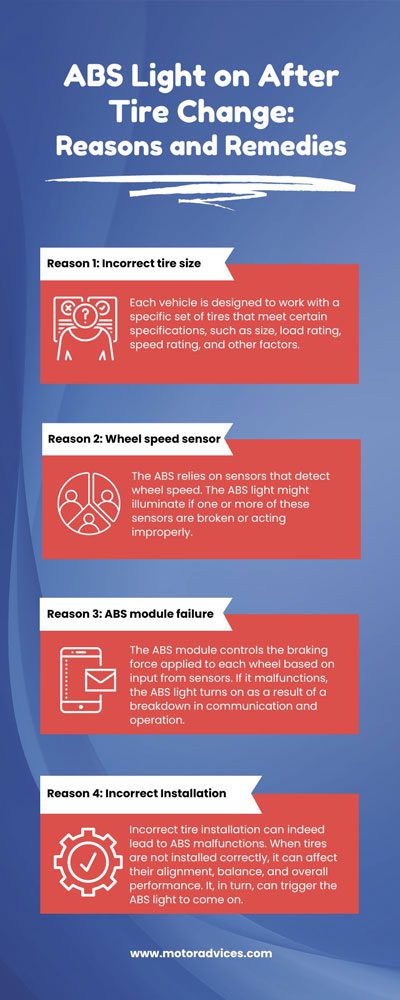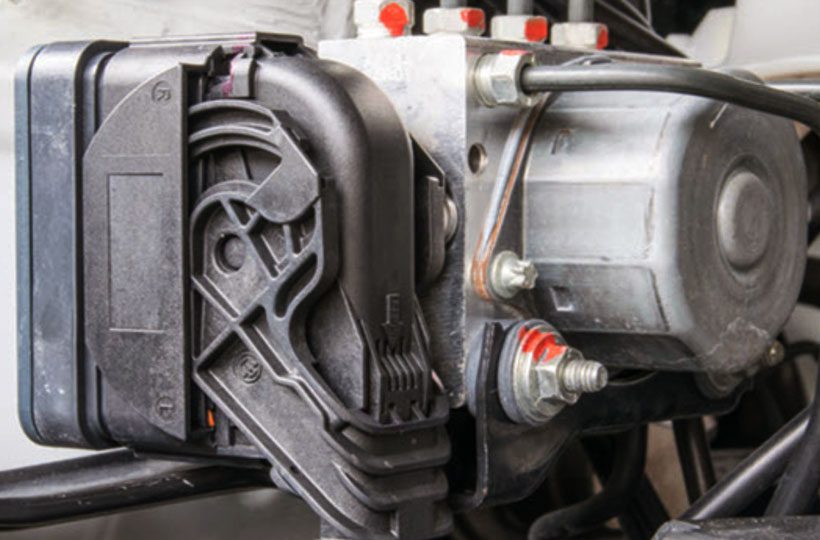ABS Light on After Tire Change: Knowing the Causes and Fixes
If you have recently had your tires changed and noticed that your ABS light is now illuminated on your dashboard, it’s possible that your anti-lock braking system has a problem. The ABS light is an important warning signal that should not be ignored, as it indicates that there may be a problem with your vehicle’s ability to brake effectively.
So, why is the car’s ABS light on after a tire change? The reasons for this include incorrect tire size, malfunctioning wheel speed sensor, and ABS module failure. Additionally, incorrect tire installation can also cause this.
In this guide, we will discuss the causes of ABS light on after tire changes. We will learn the potential fixes and additional information as well. So, keep on reading!
ABS Light on After Tire Change: Reasons and Remedies

We will have a quick look at the reasons and remedies first.No. Reasons Remedies 1. Incorrect tire size Change the tire 2. Wheel speed sensor malfunction Replace the sensor 3. ABS module failure Replace the ABS module 4. Incorrect Installation Re-install the tire
These are the key reasons for the ABS light on after a tire change in your car. Now, will have an in-depth discussion of each of the problems. So, let’s get started!

Reason 1: Incorrect tire size
Each vehicle is designed to work with a specific set of tires that meet certain specifications, such as size, load rating, speed rating, and other factors.
If the new tires that were installed on your vehicle do not meet these specifications, it can cause the ABS to detect a problem. The pro with the wheel speed, which can trigger the ABS light to come on.

Potential Fix:
To solve this issue, you need to make sure that the new tires are the correct size and type for your vehicle. Here are some points to be noted for the solution to this problem:
- Identify incorrect tire size: Check the size of the new tires against the old ones. The tire size is printed on the sidewall and includes numbers and letters representing the width, aspect ratio, and diameter of the tire.
- Check manufacturer’s specifications: Consult the owner’s manual or a qualified mechanic to ensure that the new tires are the correct size and type for your vehicle, including the width, aspect ratio, and diameter.
- Address the issue: Replace the new tires with the correct size and type for your vehicle, as specified in the owner’s manual or by a qualified mechanic.
- Check tire pressure and balance: Even small differences in tire size can affect the operation of the ABS. Make sure that the new tires are properly inflated and balanced to avoid triggering the ABS light again.
Reason 2: Wheel speed sensor
The ABS relies on sensors that detect wheel speed. The ABS light might illuminate if one or more of these sensors are broken or acting improperly. Roadside debris and weather exposure might harm the wheel speed sensors. They can also malfunction due to wiring problems or sensor calibration issues.
In addition to the ABS light coming on, you may notice other symptoms if the wheel speed sensors are damaged or malfunctioning. These can include uneven braking, a pulsing sensation when braking, or the traction control system not working correctly.

Potential Fix:
For this problem, the solution is to have the sensors checked and replaced if necessary.
A qualified mechanic can diagnose the issue by testing the wheel speed sensors with a multimeter or oscilloscope. They can also perform a visual inspection to check for any visible damage to the sensors or their wiring.
To place it, you can follow these steps:
- Step 1: Remove the wheel.
- Step 2: Check the sensor for any signs of physical damage.
- Step 3: Ensure that the sensor’s wiring is not harmed or unplugged.
- Step 4: Now, you have to reinstall or replace the sensor. If the damage is minor, you can reinstall it. Otherwise, you have to replace it.
- Step 5: After you fix the sensor, reinstall the wheel.
Reason 3: ABS module failure
The ABS module controls the braking force applied to each wheel based on input from sensors. If it malfunctions, the ABS light turns on as a result of a breakdown in communication and operation.
The ABS module can fail due to various reasons, including electrical issues, internal component failure, water damage, or general wear and tear over time. Electrical problems, such as corroded connectors or damaged wiring, can disrupt the communication between the ABS module and other components. And this can lead to module failure.
The ABS light will typically illuminate the instrument cluster when the ABS module fails. You may also experience other related symptoms, such as
- Loss of ABS functionality
- Increased braking distances
- Unusual brake pedal behavior

Potential Fix:
- Diagnostic process: Specialized diagnostic equipment is used to retrieve error codes from the ABS module, aiding in the diagnostic process.
- Addressing the issue: Solutions include repairing or replacing faulty electrical connections or damaged wiring. If the ABS module itself is faulty, it needs to be replaced and reprogrammed for proper functionality.
To replace the ABS module, you can follow these steps:
- Step 1: Gather all the necessary tools and disconnect the battery.
- Step 2: Locate the ABS module. It is located near the master cylinder or in the engine compartment.
- Step 3: By using a wrench or socket set, remove the old ABS module.
- Step 4: Install the new module as per the instruction.
- Step 5: Bleed the brake system to ensure that there are no air bubbles in the module.
Reason 4: Incorrect Installation
Incorrect tire installation can indeed lead to ABS malfunctions. When tires are not installed correctly, it can affect their alignment, balance, and overall performance. It, in turn, can trigger the ABS light to come on.
There are several potential causes for incorrect tire installation. These are including
- Inexperienced or untrained technicians,
- Negligence during the installation process,
- Using improper tools or techniques,
- Failure to follow the manufacturer’s guidelines for tire installation.
The ABS light coming on after a tire installation is a common symptom of incorrect installation. Additionally, you may experience unusual vibrations or noise while driving, uneven tire wear, or a pulling sensation to one side.

Potential Fix:
- Step 1: Diagnosing the issue: A visual inspection of the tires and wheels can help identify incorrect tire installation. A qualified technician will check for misalignment, improper seating of the tires on the rims, or any visible issues that could affect the ABS’s proper functioning.
- Step 2: Addressing the issue: The solution for incorrect tire installation is to have the tires properly reinstalled. This involves ensuring correct alignment, proper seating of the tires on the rims, and appropriate torquing of the wheel nuts or bolts.
Contact a mechanic is recommended to fix this problem. Only a mechanic can surely re-install the tire according to the right alignment and measurement.
If you’re experiencing the ABS light staying on after a tire change and would like more information, you may find our article on ABS and brake light on helpful. It provides insights into the possible reasons for both lights being illuminated and suggests steps to address the issue. Additionally, if you’re facing the situation where the ABS and traction lights are on at the same time, our article on ABS and traction light on at the same time offers explanations and recommended actions. These resources can assist you in understanding and resolving the ABS light-related concerns you may be facing after a tire change.FAQs
Don’t go away. You have something more to learn yet about the topic from the following FAQs.
Yes. Because if the tire pressure is too low, an axle movement issue may result. The ABS light may consequently seem to be on.
In some cases, the ABS light may illuminate due to a temporary fault or false indication. However, it is crucial to investigate the cause and ensure the ABS system is fully operational.
Final Words
If you notice that your ABS light is illuminated after a tire change, it’s essential to address the issue promptly. The ABS light serves as a warning that there may be a problem with your vehicle’s braking system. This guide has highlighted some common causes and potential remedies for the ABS light coming on after a tire change.
Ensuring the correct tire size and type for your vehicle and properly reinstalling tires are crucial steps to resolve the ABS light problem. It is recommended to consult a qualified mechanic for accurate diagnosis and repair.
Remember that the ABS light should not be ignored, as it can impact your vehicle’s braking performance and safety. Promptly addressing the issue will help the proper functioning of the ABS and ensure a safe driving experience.

